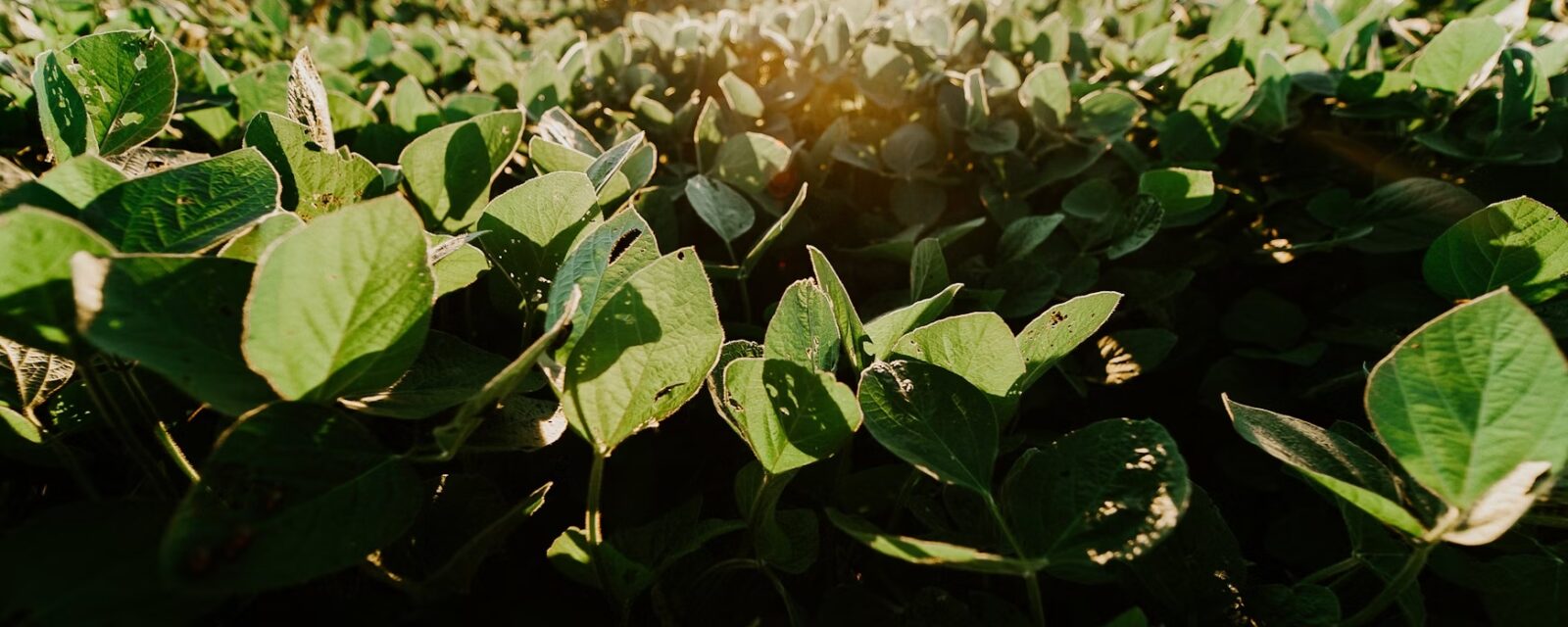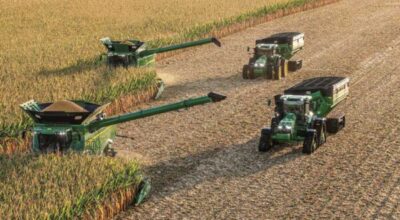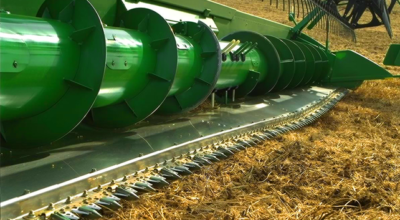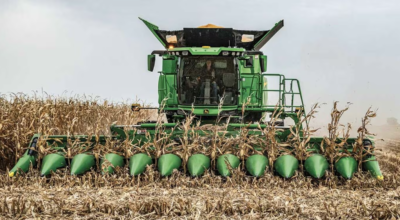Harvest timing can make or break a soybean season. Cut too early, and green pods risk dockage at the elevator. Wait too long, and you may lose brittle beans to field shatter. For farmers, knowing exactly when to roll out the combine is critical to protecting yield and profits.
In this guide, we’ll walk through how to recognize harvest-ready soybeans, key differences between single- and double-crop timing, and how you can stay efficient when every bushel counts with the help of John Deere harvesting equipment.
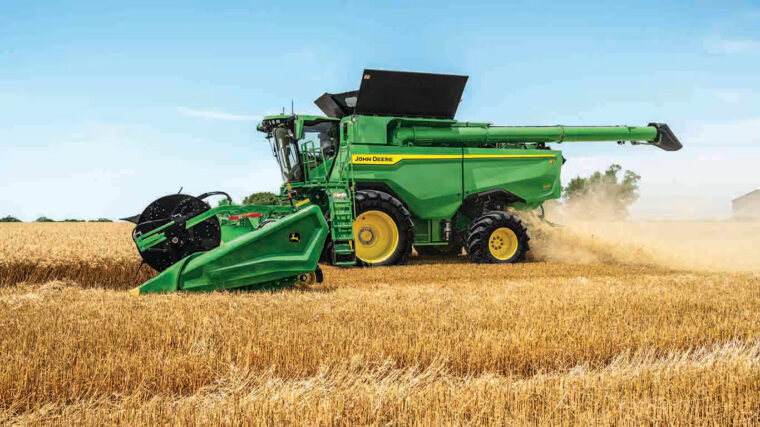
Key Takeaways
- In most regions, soybeans are harvested between late September and November, though the exact window depends on planting date, geography, and seasonal weather conditions.
- Farmers rely on in-field cues such as pod color, complete leaf drop, and seed rattle inside the pod to know when soybeans are ready for harvest.
- The ideal harvest moisture for soybeans is about 13–15%, which balances safe storage with reduced risk of spoilage or shattering.
- Harvest timing differs between single-crop soybeans planted in spring and double-crop soybeans planted after wheat harvest in summer.
- John Deere Draper Headers and S7 Series Combines are designed to streamline harvest, reduce yield loss, and keep soybeans moving efficiently from field to bin.
When are Soybeans Harvested?
Most U.S. soybeans are harvested late September through November, but the exact timing depends on your geographic location.
- Midwest: Harvest typically begins in late September through October.
- South: Harvest can stretch into November and even December, depending on weather and double-cropping schedules.
Weather variations and planting dates also shift the timeline. A hot, dry summer can push soybeans toward maturity faster, while a cool, rainy season may slow the process down by weeks. That’s why harvest timing isn’t based on the calendar alone. In-field scouting is essential to know when soybeans are truly ready.
Signs Soybeans are Ready to Harvest
The clearest signals that soybeans are ready come from the field. As you walk your rows, keep an eye — and an ear — out for these signs that your soybeans are harvest-ready:
- Pod color changes: Mature pods transition from green to yellow and finish a uniform brown. Green pods means the beans are immature; harvesting them can reduce yield by causing an uneven harvest, so it’s best to wait until the field has fully matured.
- Leaf drop: At harvest, stalks should stand bare with no leaves remaining. Complete leaf drop is a strong indicator that the plant has matured and the seeds inside are reaching harvest-ready moisture levels.
- Pod firmness and seed rattling: Pods should feel dry and firm when squeezed. Shake them, and the beans inside should rattle, showing the seed has detached from the pod wall and will separate cleanly during threshing.
- Bite test: A mature seed will crack sharply in half when bitten, rather than bending or squishing. This quick test confirms the beans are firm enough for harvest.
- Moisture levels: The target range is 13-15% moisture. To measure this, farmers commonly rely on portable grain moisture meters in the cab or field. For added accuracy, samples may be sent to local elevators or labs for testing.
Single-Crop vs. Double-Crop Soybeans
Single-Crop Soybeans
Soybeans are considered “single-crop” when they’re the only crop planted in the field for the season. These beans are planted early, usually in April or May, and are generally ready for harvest by late September through October.
Since the plants have the full growing season to mature, single-crop soybeans often deliver higher yields. The harvest window is relatively short, however, so farmers need to be ready with equipment tuned and storage prepared once moisture levels are in the ideal range.
Double-Crop Soybeans
Double-crop soybeans follow the harvest of another crop, most commonly winter wheat. After the first crop is harvested in the early summer, soybeans are planted in the same field. This practice is especially common in the South and parts of the Midwest, where growing seasons are longer.
Double-crop soybeans’ later planting means a shorter growing season, which can limit yields compared to single-crop fields. Still, producing two harvests from the same field in one season is a major advantage. In addition, farmers can often use fewer fertilizer and herbicide applications since the ground has already been prepared.
Equipment for Harvesting Soybeans
The right harvest equipment speeds up the process while protecting yield and making sure soybeans make it from field to bin with minimal loss. From the header that meets the crop first to the combine that threshes and cleans each bushel, every piece plays a role in efficiency.
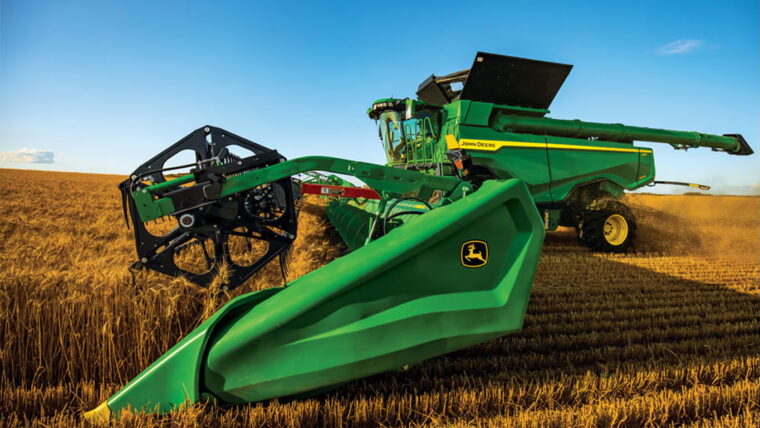
Draper Headers
A draper header is the front attachment on a combine that cuts soybeans at the base and funnels them into the machine. If you’re not sure which header is right for your farm, use the John Deere Header Selection Tool to compare HDR, RDF, and HDF models and find the best fit for your terrain and crop type.
Unlike auger heads that push the crop forward, draper headers use wide belts to move plants evenly into the feederhouse. This smoother feeding reduces shatter, prevents bunching, and helps you cover more acres in less time.
John Deere draper headers come in three styles to match your fields:
- Rigid Cutterbar Drapers (HDR35, HDR40, HDR45, HDR50): These headers deliver steady cutting across uneven fields. Hinged frames give them flexibility in rolling terrain, with wing ranges that vary from over 30 inches for the HDR 35 to over 45 inches for the HDR 50.
Position Control Gauge Wheels help you dial in your desired stubble height, while Grain Saver Draper Belts reduce cutterbar loss by 25%. The 3-piece cam reel keeps a consistent reel to cutterbar gap, even on terraces, ensuring beans feed evenly.
- RDF HydraFlex™ Drapers (RDF30, RDF35, RDF40, RDF45): With an exclusive hydraulic float system, HydraFlex™ Drapers are built to closely follow the ground in all kinds of terrain and conditions. The flexible cutterbar hugs the soil to capture low-podded beans other headers might miss.
A two-speed center feed minimizes loss, while the dual-drive, double-cut cutterbar maintains harvest quality at faster speeds. And with no header calibrations needed, you can spend more time harvesting and less time adjusting.
- HDF Flexible Cutterbar Drapers (HDF35, HDF40, HDF45, HDF50): The HDF series combines the best of both worlds with a flexible cutterbar on a hinged draper to capture more crop as conditions shift from flat stretches to rolling ground.
Like the HDR models, they use Grain Saver Belts to reduce cutterbar loss and a 3-piece cam reel for clean feeding. On the HDF35 and HDF40, a built-in Integrated Transport system makes it simple to move between fields without the hassle of extra equipment.
S-Series Combines
Whether you’re managing a mid-sized farm or pushing through thousands of acres, John Deere Combines S7 600, S7 700, S7 800, and S7 900 are designed for long harvest days, consistent quality, and reliable performance.
Across the S7 lineup, all models share key features that make soybean harvest more efficient:
- Each combine is equipped with the TriStream™ rotor, designed to thresh efficiently while reducing fuel use.
- The Dyna-Flo™ Plus cleaning system provides high-capacity cleaning to handle heavy soybean loads with less loss.
- A redesigned cab delivers greater visibility, ergonomic controls, and all-day operator comfort.
- Automation features such as Harvest Settings Automation and Predictive Ground Speed are available across all models to keep harvest consistent in changing field conditions.
- John Deere’s Combine Advisor™ takes automation even further, with tools like HarvestSmart™ feed rate automation, Active Terrain Adjustment™, and Auto Maintain with ActiveVision™ cameras. These features help operators maximize throughput while reducing losses across varying field conditions.
Here’s a quick look at how each S7 model stacks up when it comes to power and capacity:
| Features | S7 600 | S7 700 | S7 800 | S7 900 |
Unload rate | 3.6 bu/s (126.8 liters/s) peak unload rate | 4.2 bu/s (148 liters/s) peak unload rate | 4.2 bu/s (148 liters/s) peak unload rate | 4.2 bu/s (148 liters/s) peak unload rate |
| Grain tank capacity | 300-bushel (10,057-liter) | 300-bushel (10,057-liter) | 400-bushel (14,095-liter) | 400-bushel (14,095-liter) |
| Engine | JD9 9.0L | JD9 9.0L | JD14 13.6L | JD14 13.6L |
| Horsepower | 382 max engine HP | 460 max engine HP | 540 max engine HP | 617 max engine HP |
Soybean Harvest Checklist
Here’s how to prepare before harvest to protect yields and avoid disruptions:
- Scout fields: Walk several areas of your field, not just the edges, to check how evenly plants are maturing. Look for uniform pod color and complete leaf drop across the majority of the field before starting to harvest.
- Check the forecast: Soybeans are easiest to harvest and store when dry. If wet beans enter storage, they can spoil quickly, clog aeration systems, and even be docked or rejected at the elevator. Scheduling your harvest around expected rainfall can help avoid these pitfalls and maximize your yield.
- Calibrate your combine and header: Adjust settings specifically for soybeans in order to minimize losses. Taking time to fine-tune the cutterbar, reel speed, and threshing system ensures cleaner samples and smoother feeding.
- Prepare storage ahead of time: Make sure bins are clean, aeration systems are working, and moisture monitors are ready. By having storage dialed in, you prevent spoilage and keep harvested beans in top condition.
- Perform equipment safety checks: Inspect belts, guards, and hydraulics, and confirm fire extinguishers are on hand. This safety run-through reduces downtime and keeps operators protected during long days in the cab.
Harvest Soybeans With John Deere Equipment
Harvest success comes down to the right timing and equipment. Even a few days of delay or a poorly tuned machine can mean lost bushels on the ground instead of in your bins. John Deere Draper Headers and S-Series Combines help farmers move quickly, reduce losses, and protect yields.
Make sure you’re ready when your soybeans are. Explore harvesting equipment at your local John Deere dealer or browse models on MachineFinder to maximize efficiency and get the most from every acre this season.
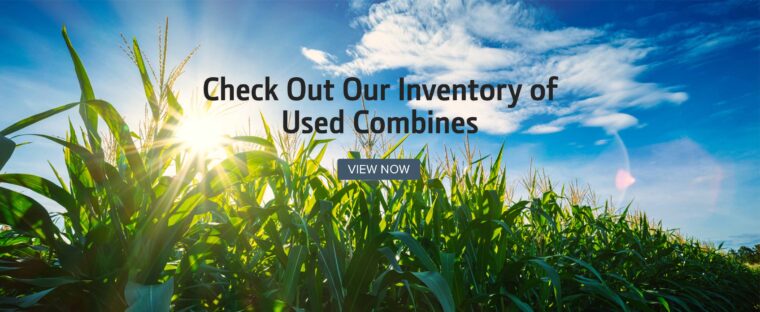
FAQs About Soybean Harvesting
1. When Do Farmers Harvest Soybeans?
Most farmers harvest soybeans between late September and November, though timing varies by region and planting date. In Southern states, harvest may extend into December.
2. What Moisture Level Is Best for Soybean Harvest?
The ideal moisture range for harvest is around 13-15%. At this level, beans are dry enough for storage without risk of spoilage but not so dry that they become brittle and prone to shattering.
3. What Equipment Is Used for Soybean Harvesting?
Many farmers use combines paired with draper headers. The header cuts and feeds soybeans evenly into the machine, while the combine threshes, cleans, and collects the crop.
4. How Late Can Soybeans Be Harvested?
In areas with longer growing seasons such as the South, soybeans can sometimes be harvested into December. However, weather risks like frost or excessive rain can affect quality if harvest is delayed too long.
